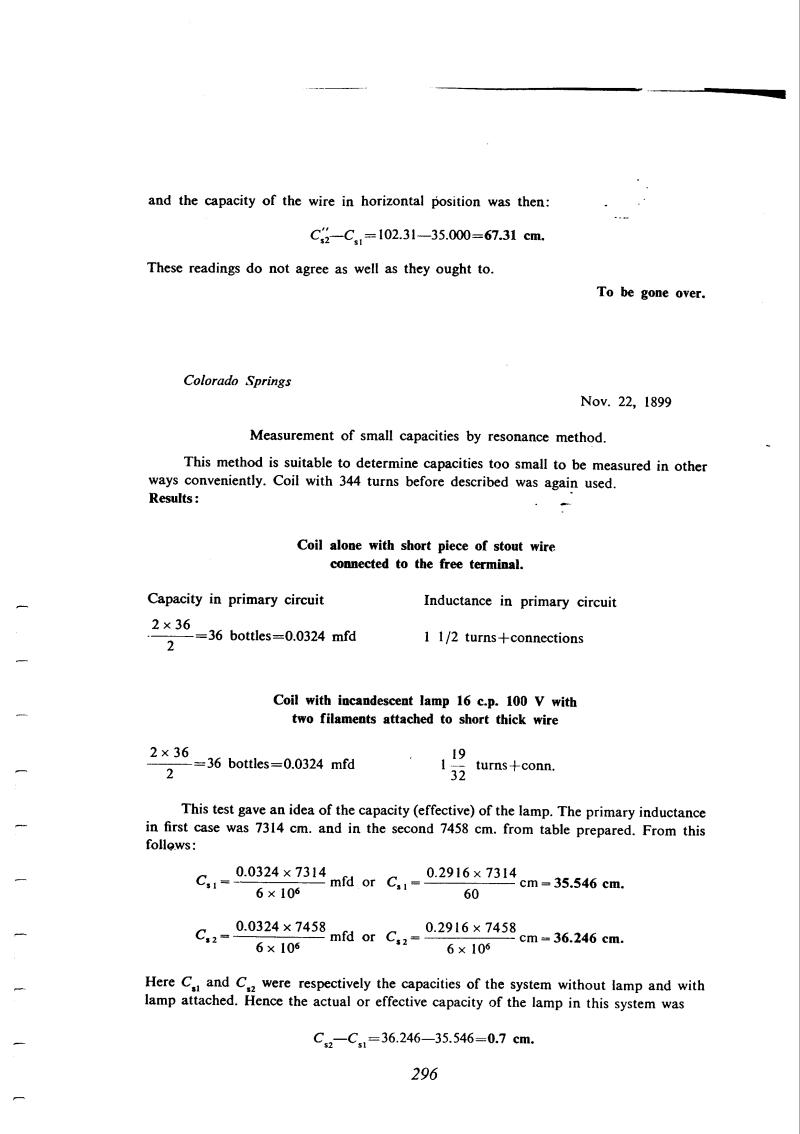
Nikola Tesla Books
and the capacity of the wire in horizontal position was then:
C''s2 - Cs1 = 102.31 - 35.000 = 67.31 cm.
These readings do not agree as well as they ought to.
To be gone over.
Colorado Springs
Nov. 22, 1899
Measurement of small capacities by resonance method.
This method is suitable to determine capacities too small to be measured in other ways conveniently. Coil with 344 turns before described was again used.
Results:
| Coil alone with short piece of stout wire connected to the free terminal. | |
| Capacity in primary circuit | Inductance in primary circuit |
| $! {{2 \times 36} \over 2} $! = 36 bottles = 0.0324 mfd | 1 1/2 turns + connections |
| Coil with incandescent lamp 16 c.p. 100 V with two filaments attached to short thick wire | |
| $! {{2 \times 36} \over 2} $! = 36 bottles = 0.0324 mfd | 1 $! {19 \over 32} $! turns + conn. |
This test gave an idea of the capacity (effective) of the lamp. The primary inductance in first case was 7314 cm. and in the second 7458 cm. from table prepared. From this follows:
Cs1 = $! {{0.0324 \times 7314} \over {6 \times 10^{6}}} $! mfd or Cs1 = $! {{0.2916 \times 7314} \over 60} $! cm = 35.546 cm.
Cs2 = $! {{0.0324 \times 7458} \over {6 \times 10^{6}}} $! mfd or Cs2 = $! {{0.2916 \times 7458} \over {6 \times 10^{6}}} $! cm = 36.246 cm.
Here Cs1 and Cs2 were respectively the capacities of the system without lamp and with lamp attached. Hence the actual or effective capacity of the lamp in this system was
Cs2 - Cs1 = 36.246 - 35.546 = 0.7 cm.
296
November 21
For some reason which he does not explain, Tesla was interested in the capacity of the same wire when vertical and horizontal, which he measured by the usual resonance method, repeating it with a different capacitance in the primary as a check. Although the results from the two sets of measurements differ appreciably, the value obtained with the wire horizontal was somewhat higher in both cases. The formulae which Tesla used July 24th here yields 54.37 cm for the vertical wire and 58.43 cm for the horizontal. These values agree well with his measurements, especially the first set.
November 21
Tesla determines the capacitance of the same wirelength when it is positioned vertically and horizontally. The measurements were performed by the usual resonant method, and for the purpose of checking he repeated the measurements with two capacitance values in the primary. Although the measurement results in the two series are quite different, in both cases the obtained capacitance is somewhat larger for horizontally positioned wire. By the application of the equation Tesla used on November 16 he obtains the vertical wire capacitance as 54.37 cm. If for the purpose of calculating the electrostatic capacitance of a horizontal conductor the equation for a metal conductor above the metal plane is applied, 58.43 are obtained. When these results* are compared with Tesla's, particularly with the first measurement series, it could be seen that the match is satisfactory.
* The capacitance of a long conductor Tesla calculated on the basis of equation: Ch = $! {L \over 2ln {L \over R}} $! (cm) where L = conductor length in cm, and R = conductor radius in cm.
The thin conductor capacitance above a metal plane at the elevation h cm, and other dimensions as above, is given with(54): Ch = $! {L \over {2ln {2h \over R}}} $! (cm)
November 22-23
Tesla performs the measurement of small capacitances in values of a few cm. These experiments illustrate the high level of the resonant method perfection in the form described on Nov. 10. The abbreviation E.R. pertains to the magazine "Electrical Review" in which Tesla published in 1896 and 1897 a series of articles on X-rays (please see comment of June 6, 1899.)

